I created this animation in the centre of the screen on a 6-inch size view. How can I make sure the ratio stays the same when it adapts to let's say an iPhone 5s. I'm not talking about Auto-Layout or constraints. I added the animation code below. This works the way I want it in a 6-inch size, but again, When I resize everything for iPhone 5s, Everything looks fine, besides the animation itself. How can I fix this?
[
iphone 6 animation screen above (This is the correct animation and how I want it to be position on the other screen size.)
override func viewDidLoad()
super.viewDidLoad() {
circleAnimationView.frame = CGRect(x: 20.0, y: 90.0, width: 300, height: 300)
self.view.addSubview(circleAnimationView)
}
The animation code is on on seperate viewcontroller, here it is:
import UIKit
class CirlceAnimationView: UIView {
var replicatorLayer1 = CAReplicatorLayer()
var dot = CALayer()
// Animation starts running
func animation2() {
// A layer that creates a specified number of copies of its sublayers (the source layer), each copy potentially having geometric, temporal, and color transformations applied to it.
replicatorLayer1 = CAReplicatorLayer()
// The layer’s bounds rectangle. Animatable.
replicatorLayer1.bounds = self.bounds
// The radius to use when drawing rounded corners for the layer’s background. Animatable.
replicatorLayer1.cornerRadius = 10.0
// The background color of the receiver. Animatable.
replicatorLayer1.backgroundColor = UIColor(white: 0.0, alpha: 0.0).cgColor
// The layer’s position in its superlayer’s coordinate space. Animatable.
replicatorLayer1.position = self.center
// calling this method creates an array for that property and adds the specified layer to it.
self.layer.addSublayer(replicatorLayer1)
// connectng the animation to the content
// An object that manages image-based content and allows you to perform animations on that content
dot = CALayer()
// The layer’s bounds rectangle. Animatable.
dot.bounds = CGRect(x: 0.0, y: 0.0, width: 12.0, height: 12.0)
//The layer’s position in its superlayer’s coordinate space. Animatable.
dot.position = CGPoint(x: 150.0, y: 40.0)
//The background color of the receiver. Animatable.
dot.backgroundColor = UIColor(white: 0.2, alpha: 1.0).cgColor
// The color of the layer’s border. Animatable.
dot.borderColor = UIColor(white: 1.0, alpha: 1.0).cgColor
// The width of the layer’s border. Animatable.
dot.borderWidth = 1.0
//The radius to use when drawing rounded corners for the layer’s background. Animatable.
dot.cornerRadius = 5.0
//Appends the layer to the layer’s list of sublayers.
replicatorLayer1.addSublayer(dot)
// number of copies of layer is instanceCount
let nrDots: Int = 1000
//The number of copies to create, including the source layers.
replicatorLayer1.instanceCount = nrDots
// The basic type for floating-point scalar values in Core Graphics and related frameworks.
let angle = CGFloat(2*M_PI) / CGFloat(nrDots)
// The transform matrix applied to the previous instance to produce the current instance. Animatable.
replicatorLayer1.instanceTransform = CATransform3DMakeRotation(angle, 0.0, 0.0, 1.0)
// Type used to represent elapsed time in seconds.
let duration: CFTimeInterval = 10.0
// animation capabilities for a layer property.
// An object that provides basic, single-keyframe animation capabilities for a layer property.
let shrink = CABasicAnimation(keyPath: "transform.scale")
// Defines the value the receiver uses to start interpolation.
shrink.fromValue = 1.0
// Defines the value the receiver uses to end interpolation.
shrink.toValue = 0.1
// Specifies the basic duration of the animation, in seconds.
shrink.duration = duration
// Determines the number of times the animation will repeat.
shrink.repeatCount = Float.infinity
// Add the specified animation object to the layer’s render tree.
dot.add(shrink, forKey: "shrink")
// Specifies the delay, in seconds, between replicated copies. Animatable.
replicatorLayer1.instanceDelay = duration/Double(nrDots)
// The transform applied to the layer’s contents. Animatable.
dot.transform = CATransform3DMakeScale(0.01, 0.01, 0.01)
}
}